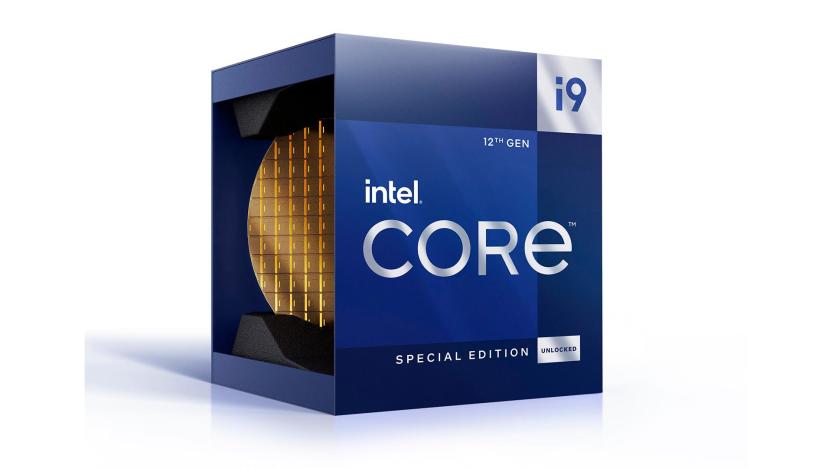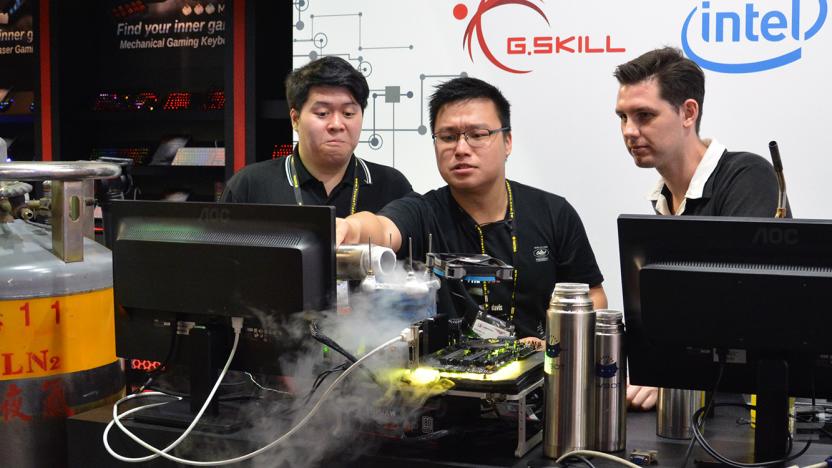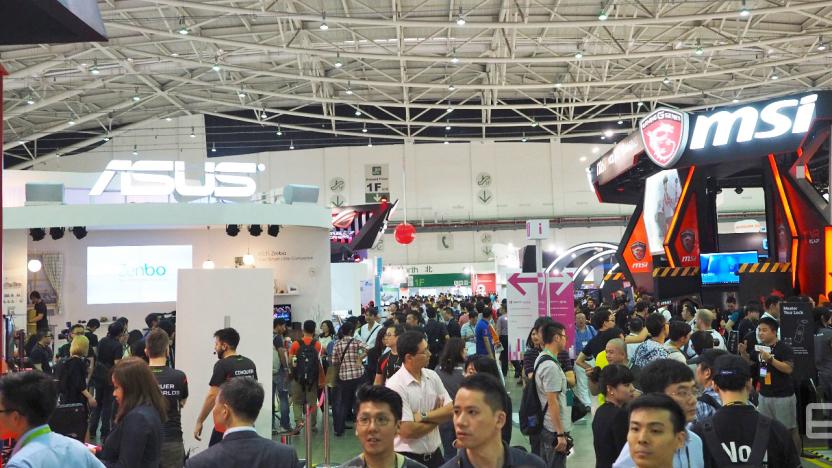overclocking
Latest

Intel says its new 5.5GHz i9-12900KS is the world's fastest desktop processor
Intel has unveiled the Core i9-12900KS "Special Edition" CPU it claims is "the world's fastest desktop processor."

Intel's Performance Maximizer tool overclocks CPUs with one click
Intel has launched a new feature designed to make overclocking more straightforward. Called the "Intel Performance Maximizer," the tool examines your processor's individual settings, then uses what Intel calls "hyper-intelligent automation" to tweak them for a performance boost. Basically, it's overclocking without having to fiddle around with custom settings in BIOS yourself.

Pushing a 28-core CPU to its limits: 6GHz and beyond
I'm mesmerized by the way liquid-nitrogen vapor flows across the motherboard. There's something oddly therapeutic about extreme overclocking, especially when the cold air gently touches my skin, making even the tiniest bumps in clock speed the more worthwhile. There's probably no better place to see it in action than Taipei's Computex, where gaming PC memory maker G.Skill gathers the world's best overclockers for its OC World Cup event (with a $10,000 top cash prize). Our previous attempt to tame the 18-core Intel Core i9-7980XE was already rather ambitious, but this year, we decided to go all the way with the massive 28-core, 255W Intel Xeon W-3175X, a rare CPU gem that costs at least $3,000 -- if you can even find one. Our goal was to break the chip's records at the time: pushing it from its 3.1GHz base frequency to beyond 5.68GHz on Cinebench R15, or at least beyond 6.5GHz via the more lightweight CPU-Z validation. With this many cores, it posed a much bigger cooling challenge to run at higher speeds, especially compared to the quad-core i7-7700K I tinkered with the year before.

You can now overclock your PlayStation Vita for reasons
Today, Wololo spotted that the PSVita plugin LOLIcon can overclock the handheld's CPU beyond its official limits. This allows the CPU to operate at 494 MHz, which is not officially supported.

Apple's slim MacBook Pro design could be holding back its i9 CPU
The 2018 15-inch MacBook Pro lets you crank up the processor power by swapping in an Intel 2.9GHz six-core Core i9 CPU for an extra $300. But the chip seems to be struggling when it's handling power-hungry tasks, to the point where the average clock speed is vastly below the advertised performance of the CPU. Some tests even showed that it fared worse than the i7 model.

I tried to beat an overclocking robot and failed
Extreme overclocking is hard. I had my first taste of this delicate hobby at last year's Computex, in which, with a lot of back and forth between pouring liquid nitrogen and torching, I managed to push Intel's 4.2GHz Core i7-7700K processor to an epic 7GHz. Still, I had it easy. Professional overclockers from G.SKILL and HWBOT had set everything up in the first place. Even the pros can find this all a little mundane. EVGA's Vince "Kingpin" Lucido and Illya "Tin" Tsemenko are well-known for their GPU-overclocking records over the years, but they, too, grew tired of the tedious "monkey work," to the point where they decided to build a rig that could overclock itself. The result is the Roboclocker, a PC that can intelligently and efficiently pump liquid nitrogen to both its CPU and GPU. While this may not be the first automatic liquid-nitrogen-overclocking rig, it's the first of its kind to actually break records.

Overclocking to 7GHz takes more than just liquid nitrogen
Over the years, I've been fascinated by two kinds of events at Computex: esports and extreme-PC-overclocking competitions. I doubt I'd ever make it as a professional gamer (I'm more of a Counter Fight kind of guy than a Counter-Strike man these days), but I'd jump at any opportunity to pour liquid nitrogen onto a PC motherboard, because even if I screw something up, chances are I'd still look cool doing so. It just so happened that at this year's Computex, gaming-accessory maker G.SKILL invited me to its extreme-overclocking workshop behind its contest stage. As a total newbie with absolutely zero knowledge of overclocking, I quickly took up this offer.

What to expect at Computex 2017
We're pretty much halfway through the year, which means it's Computex time. As usual, you'll find a handful of us running around the Taipei show floors next week, where we'll be getting our hands dirty with the latest PC products and components. Last year was relatively fruitful, thanks to what was then a recent VR explosion. Several PC brands introduced high-end GPUs or affordable ones capable of running VR. Even Intel surprised its hardcore users with its first 10-core desktop CPU. ASUS topped it all off with Zenbo -- an adorable $600 home robot that went on sale in Taiwan earlier this year. This year, however, is bound to be quieter. For one, Microsoft already stole some of Computex's thunder with its own events earlier this month, so we're not expecting anything major from it next week. Intriguingly, HTC Vive has no official presence at Computex this year, which means less VR. Still, based on recent leaks and launches, we have at least a rough idea of what to expect.

How to build a high-end, overclocked PC (as written by an idiot)
This is not an article from a PC virtuoso who builds water-cooled, quad-SLI gaming rigs with not a wire out of place. Nope, it's by a guy who's fantastic at buying stuff on Amazon, but more likely to start an electrical fire than build a sophisticated PC. But that's never stopped me before! So, with a screwdriver in one hand and unmerited self-confidence in the other, I set out to build an overclocked Intel Haswell-E Core i7 machine for video editing, 3D animation and light gaming. Whatever could go wrong?

Windows 8 found to skew benchmark results on overclocked hardware
Overclocking may yield impressive benchmark results, but it turns out scores from Windows 8 PCs may not be reliable. The management at overclocking community HWBOT has discovered that tests provide inaccurate stats when then CPU base clock frequency is fiddled with from within the OS. Hardware-based real-time clocks (RTCs) help keep accurate track of time, but the operating system's timekeeping somehow slows down or ramps up when processing speeds are tweaked. When underclocked by six percent, the outfit's Haswell-infused system lagged 18 seconds behind actual time, fooling the benchmark into a higher score since it seemingly finished in a shorter period of time. Conversely, a boost to CPU speeds results in a lower mark as the internal timepiece ticks away faster than usual. However, modifying processor speeds at boot time avoids these issues. As a result of the revelation, HWBOT is no longer accepting benchmarks from computers running the eighth iteration of Ballmer and Co.'s software, and will invalidate those already in its database. "Simply no benchmark – not even 3DMark – is unaffected by Microsoft's RTC design decisions," the outlet adds. The timing issues are said to stem from Windows 8's support of disparate hardware setups, including embedded and budget PCs that don't have a fixed RTC. If you'd like to see the inconsistencies for yourself, head past the break for video proof.

Intel leak reveals 8-core Haswell-E series desktop CPU for late 2014
Now that Haswell's available in consumer-grade laptops, it's time to look at what's next on Intel's to-do list. A leaked slide-deck is claiming that Haswell-E, the enthusiast version of the chip, is coming in the second half of 2014. The documents also promise that Intel will axe the 4-core base model in favor of 6-and-8-core editions of the CPU, which can pack up to 20MB of L3 cache. At the same time, the company is likely to release the Wellsburg motherboard chipset, which can support DDR4 RAM with a clock speed of up to 2,133MHz. If it's all to be believed, then we have one word of advice to the overclocking community -- best start stocking up on liquid nitrogen.

AMD Trinity APU overclocked at 7.3 GHz, kept cool with liquid nitrogen
AMD's Trinity APUs have only been in the wild for a few days, but some have already taken on the challenge of pushing the new desktop silicon to its limits. By giving the A10-5800K model 1.956 volts, disabling two of its cores and cooling it with liquid nitrogen, overclockers were able to push the chip to 7.3GHz. Air-cooling and 1.616 volts squeezed out 5.1GHz without sacrificing any cores. If you're a mere mortal who's fresh out of liquid nitrogen (or never had any to begin with), you should be able to comfortably bump CPU performance by roughly 10 percent and GPU speeds by 15 to 17 percent. For the full specs on this particular overclock, hit the source links below.

Raspberry Pi's new turbo mode boosts performance by roughly 50 percent, doesn't void warranties
Giving a Raspberry Pi extra voltage is a quick way to squeeze out additional processing power and void its warranty, but the folks behind the tinker-friendly board have devised a turbo mode that boosts performance by roughly 50 percent while keeping warranties intact. After studying the effects of temperature and voltage on the hardware's lifespan, the team found that dynamic overclocking and overvolting doesn't affect the Pi's health appreciably. As a result, speeds can be pushed from 700MHz to 1GHz only when additional horsepower is needed, and things are reined back in when the CPU grazes 185 degrees Fahrenheit (85 degrees Celsius). Benchmarks show the extra computing oomph makes the Pi 52 percent faster on integer, 64 percent speedier on floating point and 55 percent snappier on memory tasks. The new mode is available in the latest firmware update, which also includes temperature and frequency widgets, better analog audio, improved USB performance and support for WiFi dongles out of the box. For the technical nitty-gritty and more details on the upgrade, hit the source link below.

Digital Storm unveils X17E gaming laptop, pushes your CPU to 4.5GHz for frenzied fragging
Specialist gaming outfit Digital Storm has busted out its new X17E gaming laptop, designed to keep you entertained without too much grunting. The 17-inch unit comes with a 1,920 x 1,080 display, a choice of GeForce GTX 680M or Radeon 7970M and an Intel Core i7-3910XM, which the company's engineers reckon can be stably overclocked to a whopping 4.5GHz. It's got the usual raft of features you'd expect in a high end unit, including support for 32GB RAM, USB 3.0, eSATA, Blu-Ray and a backlit keyboard you can tweak to your needs. The base model will be out at the end of September, setting you back $1,753, while a signature edition with a custom paint-job will come later, and cost you more.

Google Nexus 7 overclocked to 2GHz, punches well above its weight
The stock Nexus 7 peaks at a 1.3GHz clock speed when it's at full burn. That's certainly good enough for the $199 price tag, but eager adopters have just hit a new record in trying to wring out even more of a bang for the buck. Courtesy of a custom Elite kernel from XDA-Developers' Clemsyn, the Tegra 3 in the mini tablet will scale all the way to a heady 2GHz. You'd be right in suspecting that it leads to some dramatic speed boosts: the Nexus 7 at this pace can put a Transformer Prime to shame in common benchmarks, let alone most smartphones. Reaching the loftier heights of performance does require nerves of steel, however. The Elite kernel is very much a rough build that the creator doesn't yet trust with the public, and NVIDIA's processor is already known to get toasty under significantly added stress. There's hope a refined kernel will make for a safer venture into unknown territory. If you can't wait to throw at least some caution (and the warranty) to the wind, though, hit the second source link for code that will reach a slightly less melt-prone 1.8GHz.

AMD Radeon HD 7970 could get 'GHz Edition', put the hurtz on NVIDIA
AMD's Radeon HD 7770 and 7870 reference cards already sport 1GHz clock speeds, but so far the high-end flagship 7970 has been stuck at 925MHz. That'd be no big deal, perhaps, were it not for rival NVIDIA's benchmark-stealing GeForce GTX 680, which autonomously adjusts its clock speed on the fly and easily hits 1.2GHz under the right conditions. But while NVIDIA has yet to roll out its full stack of 28nm cards, AMD is finding plenty of time to play catch-up. According to Australian site Atomic MPC, the company has revealed that the manufacturing process of its next-gen GPUs has improved to the point where the same average voltages can yield much higher clock speeds. Recent chips can reach 1.25GHz without struggling, which means a conservative "GHz Edition" of the 7970 can now safely be rolled out, of course with scope for much higher overclocking on third-party boards with more robust coolers. By the time the battle between Red and Green reaches full-swing, it might not be so easy to call a winner.

Origin PC EON15-S and EON17-S gaming laptops available now, priced from $1,525
In the market for a beastly portable gaming rig that won't break the bank? Origin PC today announced availability of its EON15-S and EON17-S gaming laptops, with pricing starting at $1,525 and $1,576, respectively. You'll of course still be able to hand over an arm and a leg depending on how you opt to build out your system, but considering that the base model is priced at nearly half the amount its predecessor was when it was announced this time last year, we imagine additions will wield a softer blow than they did in 2011. Both systems include Intel HM77 Ivy Bridge chipsets, NVIDIA GeForce GTX 660M, 670M or 675M graphics with Optimus power-conservation technology, and a 5.1 ONKYO surround sound system. Both cases offer unique designs, with black, red, silver or custom finishes, and a colorful backlit keyboard. What else could you possibly need? Perhaps a press release and a few more pictures -- and we've got both for you right here.

Digital Storm launches Aventum range with Cryo-TEC cooling system
The last thing you want when things are getting hot in the battlefield, is for things to start heating-up under your desk too. Digital Storm's been back in the lab, looking for ways to prevent just that, and thinks it's cracked it with the new Aventum system. It's the first to be kitted out with the PC-maker's Cryo-TEC liquid cooling mechanism, and boasts a thermal exhaust, five software-regulated "zones" and no less than 13 configurable fans. The range starts with an Intel i7 2700K core, 16GB RAM, 120GB SSD (1TB HDD) and a GeForce GTX680 for $3,859. If your pockets are even deeper, then you might fancy the 2x dual Xeon E5-2630 hexacore-totin' system with 32GB DDR RAM, and three-way SLI (with the same GeForce GTX680) for a jaw dropping $7,856. With a price like that, however, it's probably your credit card that'll need cooling down. Digital Storm is taking orders as of today, and full details of the range in the PR after the break.

SetCPU gets an ICS-like overhaul, makes overclocking easier to do
Rooting has gotten a bit easier in Android land as of late, what with certain OEM's getting officially on board with unlock tools. For those who can claim O.G. residence in this underbelly of Rubin's mobile kingdom, however, a premium app known as SetCPU should ring a familiar bell. That Google Play application, useful for overclocking processors, has recently gotten a face lift, aligning its design more closely with Ice Cream Sandwich's visual flair while nixing the previously complicated interface and its dense jargon-y fluff in the process. Included in this version 2.3.0 update is a new frequency slider, governor menu for adjusting processor scaling, added support for multi-core devices and a slew of bug fixes. Sadly, phones sporting Eclair and below have been dropped, but chin up, you can always head to HTC Dev to pursue that Dream.

Intel offers overclocking protection plan, takes Cash4CPUs
For a certain subset of tech geeks, it can be hard to live with the knowledge that raw processing power lies untapped within their machines. And it's typically those users that indulge in a bit of overclocking, pushing their CPUs to the limit, often resulting in unstable performance or even a fried processor. Give a hand, then, to the folks over at Intel, who have heard your nerd pleas and are offering up an extended safety net so you can continue to code dangerously. Dubbed the Performance Tuning Protection Plan, this optional add-on for unlocked processors (ending in X or K) reaches beyond the standard three year warranty to give users a one-time replacement. You'll still have to cough up some cash -- about $20 to $35 depending on what your computer's packing -- but that's still a small price to pay for a second chance at silicon thrills.











